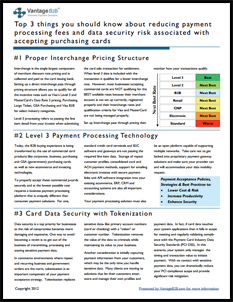Setting the Right Payment Acceptance Policies Key to Savings & Security
In addition to popular consumer oriented products like debit cards and rewards cards, today’s buyers are using several types of commercial card products including business, corporate, fleet, purchasing and GSA purchasing cards. Establishing payment acceptance best practices helps manage different payment choices for competitive advantage.
Policies to reduce payment acceptance costs
- Insist on a Interchange pass through pricing structure.
- Implement Level 3 processing technologies and train your staff.
- Mange your Interchange qualifications and your effective cost with PayView reporting.
- Set your refund policy to take advantage of credit voucher Interchange.
- Add ACH as a payment choice to lower cost payment options.
- Use Tokenization to reduce the scope of your PCI compliance efforts.
- Limit or eliminate pre-authorizations of sales orders.
Common Card Authorization Examples:
- Authorize and settle at the time of order (provided you have quick fulfillment). In all cases, the best practice for card acceptance is to authorize and settle the card at or very near the time of shipment/delivery. Authorization amount must equal settlement amount.
- Authorize at the time of order and settle later at time of shipment. Caution here, you can not qualify for Level III Interchange if you use Authorization Only and Force/Offline functionality. Using this payment policy will downgrade your transactions to Electronic/Standard pricing and prevent Level 3 Interchange rate qualification.
- The best practice work around practice is to NOT obtain a pre-auth. Instead simply capture the card and customer data using a payment token technology then complete the charge at the time of the fulfillment.
- Authorize and settle at some later time (ex. same timing as a check payment). Avoid extending 30 day trade credit terms only to pay the Interchange fees to accept a card payment. When taking card payments, take them in place of extending terms.
Different Rules for B2B Transactions:
A Vantage B2B ecommerce consultation will help you design your work flow in a way to help solve common problems including issues of unknown shipping charges at time order is placed, back orders, out of stock, multiple fulfillment such as different locations, multiple shipping charges, multiple delivery schedules, etc.
- What most merchants know (have always done) is to use Authorization Only and Force procedures. However the problem is that the card companies have changed their rules over the years and now strongly discourage this practice. For example, today Visa B2B transactions MUST have a matching authorization amount and settlement amount. The Visa system performs edit checks and may reject the transaction altogether (causing the merchant to reprocess the transaction with a matching Authorization and Settlement amount in order to be paid). Also, transactions performed initially with an Authorization Only that are later Forced for settlement can NOT qualify for Level 3 pricing. Penalty transaction fees are also charged for unused authorizations, zero dollar auths, etc.
A Vantage Payment Advisor can help recommend best practices to avoid these issues.
Policies to reduce payment acceptance risks
- Understand that card payments are a convenience form of payment, not a guaranteed form of payment.
- Know what an approval code means.
- Understand your responsibilities to know your customer.
- Set your own internal risk limits for new customers, spending limits and frequency, rush deliveries and international orders. Not all orders or customers should qualify for the privilege of using a card payment.
- Understand how to use AVS and CVV codes to mitigate fraud.
- Match the ship to and card billing addresses and know why they differ. Set shipping policies to obtain proof of delivery for high value orders.
- Use caution when presented with multiple cards all from the same bank (same first six digits). Do not split sales across multiple cards.
- Clearly publish your refund policy and obtain proof of cardholder acknowledgement.
Work with a VantageB2B Payment Advisor to discuss this guidance in greater detail and for help developing a payment acceptance roadmap to lower costs, increased security and greater efficiency.
